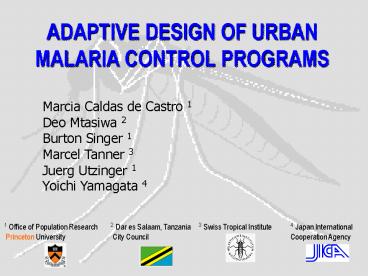ADAPTIVE DESIGN OF URBAN MALARIA CONTROL PROGRAMS - PowerPoint PPT Presentation
Title:
ADAPTIVE DESIGN OF URBAN MALARIA CONTROL PROGRAMS
Description:
... .00 1991.00 20600.00 15900.00 36500.00 1992.00 30750.00 22600.00 53350.00 1993.00 50500.00 25000.00 75500.00 1990.00 24119.00 38450.00 62569.00 1991.00 31670 ... – PowerPoint PPT presentation
Number of Views:70
Avg rating:3.0/5.0
Title: ADAPTIVE DESIGN OF URBAN MALARIA CONTROL PROGRAMS
1
ADAPTIVE DESIGN OF URBAN MALARIA CONTROL PROGRAMS
Marcia Caldas de Castro 1 Deo Mtasiwa 2 Burton
Singer 1 Marcel Tanner 3 Juerg Utzinger 1 Yoichi
Yamagata 4
1 Office of Population Research Princeton
University
2 Dar es Salaam, Tanzania City Council
3 Swiss Tropical Institute
4 Japan International Cooperation Agency
2
CHARACTERISTICS OF SUCCESSFUL MALARIA CONTROL
PROGRAMS
- Environmental management is the central focus,
with several interventions/surveillance methods
acting simultaneously. - Tuning the package of interventions to minimize
the number of malaria cases per year is an
adaptive process involving ongoing performance
evaluation of each of the tools and the outcome
measure (interventions are adjusted over time in
response to these evaluations).
3
- 3-5 years were required before a given package of
interventions exhibited high level performance. - Diagnosis of malaria cases, anti-malarial drugs,
bed-nets, and the use of chemical insecticides
(following the discovery of DDT) were necessary
but not sufficient (for success) components of
the program. - Program staff contained people knowledgeable
about entomology, hydrology, epidemiology/ecology,
and clinical aspects of malaria. - The implementation strategy, including the mix of
tools employed, was highly idiosyncratic to the
particular locality.
4
a) Roan Mine
5
A.Gambie and A.Funestus larval habitats
- A.Gambie
- Open and un-shaded natural or man-made pools of
standing water, near rivers and tributaries - Open water tanks and nature wells loosely
overgrown with grass - A. Funestus
- Shaded banks of rivers and tributaries
- Swamps and flooded areas with partial shade
6
Biting pattern
7
Reduction of Average Monthly Malaria Rate and
Total Malaria Cases after the Implementation of
Malaria Control Program - (1930-1933)
8
Average Monthly Malaria Incidence Rate and Annual
Malaria Cases at the Roan Antelope Mine between
1944 and 1949
9
b) Nkana Kitwe Mine
10
Reduction of Malaria Incidence at Nkana-Kitwe
Mine between 1935-1943
11
Reduction of Malaria Incidence at Nkana Mine
between 1944-1950
12
Malaria, Rainfall, and Anopheles Statistics at
the Roan Antelope Mine between 1944-1949
13
Urban Malaria Dar es Salaam, Tanzania
14
Dar es Salaam
Area Study
Africa
15
Urbanizationin Dar esSalaam
Source http//mshand.geog.gla.ac.uk/DAR/Tanzania.
htm
16
- Land Use -Vegetable Production
Source http//www.cityfarmer.org/daressalaam.htm
l
17
History of Malaria Control in Dar es Salaam1902
- 1961
- 1902-1912 German Colonial GovernmentDrainage,
soil modification, bednets - 1912-1918 German ordinances for controlling
breeding sites proscribed urban agriculture
(potatoes and other ridge-and-furrow type
cultivation - 1918-1961 British ProtectorateContinued
drainage works, stronger legal measures - 1920 Sanitation Branch established
East Africa Malaria Unit established - 1951 Tanganyika Malaria Service
18
History of Malaria Control in Dar es SalaamPost
colonial period
- 1961 Urban mosquito control integrated into
general health services - 1971 Integrated malaria control experimentDar
es Salaam City Council WHO East Africa Aedes
Research Unit - 1980 Reduction in size of central malaria
control unit Consequential to adverse economic
conditions (1970s high inflation) - 1988-1996 JICA Malaria control
initiativeJapan-Tanzania bilateral project
19
- Breeding Sites - Aerial Observation
Misimbazi Creek
20
Breeding Sites - Aerial Observation
Temeke
21
- Breeding Sites - Aerial Observation
Regent State Kijito-Nyama
22
Breeding SitesMalaria Risk Mapping
Dar es Salaam, 1993
23
Breeding SitesMalaria Risk Mapping
24
Breeding SitesMalaria Risk Mapping
25
Breeding SitesMalaria Risk Mapping
26
Breeding SitesMalaria Risk Mapping
27
Interventions StrategyIndoor Residual House
Spraying (IRHS) and Larvicide
Kisarawe
Selected schools
Pagu Kajungeni
28
Effect of Interventions - IRHS
29
Effect of Interventions - Larvicide
30
Effect of InterventionsBoth IRHS and larvicide X
no intervention
31
Total Length of Drain Cleaned(cumulative -
meters)
Dar es Salaam
Tanga
32
- Program Implementation -Based on successful
programs in the past
- Environmental management is the central focus,
with several interventions/surveillance methods
acting simultaneously. - Tuning the package of interventions to minimize
the number of malaria cases per year is an
adaptive process involving ongoing performance
evaluation of each of the tools and the outcome
measure (interventions are adjusted over time in
response to these evaluations).
33
- 3-5 years were required before a given package of
interventions exhibited high level performance. - Diagnosis of malaria cases, anti-malarial drugs,
bed-nets, and the use of chemical insecticides
(following the discovery of DDT) were necessary
but not sufficient (for success) components of
the program. - Program staff contained people knowledgeable
about entomology, hydrology, epidemiology/ecology,
and clinical aspects of malaria. - The implementation strategy, including the mix of
tools employed, was highly idiosyncratic to the
particular locality.































